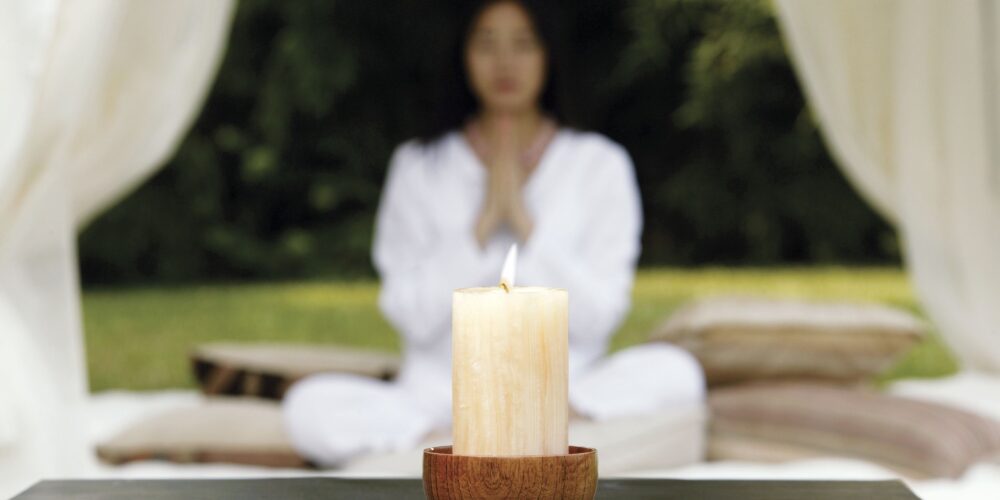You fought with your best friend and now you’re sitting in the class thinking all about it. You’re filled with a lot of anger and a little bit of sadness, and trying to figure out whose fault it was.
You’re also thinking about what will happen when you face your best friend the next time. You’re thinking, “How awkward is that moment going to be?”, “Will I be able to make eye contact or should I just ignore and keep a straight face?”
You’re re-living all those past events, and visualizing the future events in your head while the entire class moves on to the next chapter of that subject.
The human mind is a natural time traveler. It must have happened to all of us that our minds either slipped into the past or leap into the future unconsciously.
So much of our time goes into thinking about stressful events that have either already happened or are going to happen that we miss out on the present.
Whether you’re a student, a working professional, or a homemaker, chances are you spend a lot of time thinking about worries from the past or anticipating stress from the future. While that is a problem, it’s part of being human.
The human mind has a wandering nature. It jumps from one thought to another, and if you think about it, most of the time your mind is not in the present moment, it’s either in the past or in the future.
At times, it’s thinking about the things that are far from reality, some alternate reality that your mind has conjured up. The reality you create when you think about “what if” this happened.
The important thing to understand here is that the only time we have to do something is in the present. If we keep re-living the stressful moments of the past or keep thinking about the future where everything will perfectly align together, the present moments will pass before we know it.
This is precisely where mindfulness comes in. From the sound of it, it might seem like an abstract concept reserved for meditation gurus to be done at mountain tops, but in reality, it’s a practical and accessible approach to living your life to its fullest.

Welcome to the first blog of our series on mindfulness, which is an introduction to what mindfulness is. In this blog, we’re going to understand the essence of mindfulness, we’ll learn a little bit about its history, and why is mindfulness a superpower in the modern world.
Let’s begin.
Table of Contents
What Is Mindfulness In Simple Terms?
Mindfulness in the simplest of terms is your ability to stay in the present moment. It’s about living without the constant chatter of your mind pulling you into the past or catapulting you into the future.
It’s a practice that enables you to live and experience the current moment with a sense of openness, curiosity, and non-judgment.
Mindfulness is about anchoring your attention to something happening right now, rather than what has already happened or going to happen. It could be something as simple as the sensations of your breath as it enters and leaves your body.
Now you might think that to be fully present in the moment, you have to consciously suppress your existing thoughts or emotions. But in reality, it’s about acknowledging that yes, the mind wanders, and feelings arise, but you have the power to choose how to respond.
It’s the understanding that you are not your thoughts, you are the one witnessing them.
It is something you can practice in your daily life. You don’t have to go to meditation centers or retreats to practice mindfulness, rather you can infuse awareness into daily ordinary moments.
For instance, has it ever happened to you that you made yourself a nice cup of tea or coffee that you planned to enjoy while flipping through the newspaper or doing household chores, and before you realized it, the cup was already empty?
The experience you were longing for went unnoticed.
Compare it with sitting in a cozy corner, feeling the warmth of the cup against your palms, inhaling the delightful aroma, and savoring each sip you take. Suddenly, that same cup of tea or coffee will turn into a rich experience.
Mindfulness allows you to experience the present moment to its fullest without worrying about the past or future. It is very helpful in stress management because when you’re under stress, it provides a pause – a moment to breathe, observe, and respond rather than react impulsively.
It’s a tool that allows you to come out of the autopilot mode and take charge of your life. It’s a very simple concept to wake up to the richness of each moment. To cultivate a mind that is clear, focused, and compassionate.
But how did Mindfulness come about?
A Brief History Of Mindfulness
Mindfulness is a popular concept in today’s world throughout the globe but its origin can be traced back to ancient Vedic texts of Hinduism, the oldest extant religion in the world. Yoga, meditation, and mindfulness, all have their roots in Hinduism.
The word mindfulness comes from the Pali word “sati” which roughly translates as “fullness of awareness”. This awareness is believed to be the key to achieving inner peace and well-being. Mindfulness is one of the key concepts of Hindu, Buddhist, and Taoist practices.
Buddhist monks began formalizing the practices of mindfulness in the 1800s, and this concept has been adopted by many different cultures around the world since then, each with its unique interpretation and approach to it.
The practice of mindfulness has become increasingly popular in the Western world over the past few decades. Jon Kabat-Zinn started the mindfulness program for stress reduction at the University of Massachusetts Medical School in 1979.
It has been used to treat mental and physical health issues, and it is becoming more and more popular nowadays because it is very effective in coping with stress and anxiety.
As we’re becoming increasingly aware of mental health, the conversations around mindfulness are also evolving.
What Are The Key Concepts Of Mindfulness?
Before you learn how to practice mindfulness, it’s important to understand the basics. The foundational pillars that shape this practice. Let’s take a closer look at these fundamental principles that form the bedrock of mindfulness.
Awareness of the Present Moment
At the heart of mindfulness is awareness of the present moment. If life is a series of moments, and each moment is a unique snapshot in time, then awareness of the present moment means fully engaging with the current snapshot without looking at the previous or the next one.
To be aware of the present moment is to step into the raw, unfiltered experience of life. It’s the difference between merely existing and actively participating in the unfolding of each moment.
Our minds are often occupied with thoughts about what was or what might be, which makes us miss the richness of what is happening right now.
In mindfulness, the present moment is not seen as a means to an end but as a destination in itself. It’s like stopping to smell the roses – not to reach a destination but to relish the fragrance along the journey.
Whether it’s the warmth of sunlight on your face, the sound of raindrops on a window, or the laughter of a loved one, awareness in the present moment is about being open to the full spectrum of experiences life offers.
But it’s not always easy to maintain awareness in the present moment. Our minds have a wandering nature and it often pulls us into a stream of thoughts about the past or future.
Yet, the practice of mindfulness is not about eliminating these thoughts, but about gently bringing your attention back to the present whenever you notice it drifting.
Non-Judgmental Observation
The practice of non-judgmental observation is about fostering an open-minded awareness where you create a space for self-discovery, acceptance, and a deep understanding of the complexities within us.
Imagine your mind as a spacious sky and thoughts as passing clouds. Instead of labeling these clouds as good or bad, right or wrong, let them drift by and observe without attachment.
Think of a time when you were frustrated, if you’re married then chances are that it wasn’t that long ago 😉. Now if you cultivated a non-judgemental approach, you would not criticize yourself for feeling frustrated, nor would you try to suppress or alter that emotion.
Instead, you’ll observe it with a kind and curious gaze and think, “What triggered this frustration?”, “How does it manifest in the body”
When you allow these emotions to exist without judgment, you gain insight into your inner world and foster a compassionate relationship with yourself.
And it’s not just about your inner world, non-judgmental observation extends to the external world as well. It’s about meeting each moment with a fresh perspective without having preconceived notions or biases.
For example, enjoy the rain or the sunset without labeling it as good or bad, beautiful or not. When you let go of these judgments, you open yourself to the uniqueness of the experience.
Just observe.
It’s not about becoming indifferent or passive, but having an active engagement with the reality of each moment. It’s about realizing that as humans, we are prone to judgments but it is up to us how we respond to them.
And when you distance yourself from the judgments, you develop a capacity to respond with clarity and compassion.
Acceptance and Letting Go
As individual human beings, we have a very limited view of life. And in any given situation, there are so many factors at play that are beyond our control. Acceptance is understanding this fact, the reality of the present moment without resistance.
For instance, a river flows in a single direction only. Acceptance is understanding it and trying to swim in the same direction as that of the current rather than desperately trying to go against it.
When you face a challenging situation, accepting it doesn’t mean you have to endorse it. Instead, it’s about acknowledging the reality and choosing how to respond with a clear mind and an open heart.
Letting go is about releasing your grip on the attachments, expectations, and the need for control. It’s about having the understanding that just like the flow of the river, there are elements of life beyond your influence.
Imagine holding onto a handful of sand, the tighter you grip, the more slips through your fingers. Letting go is the art of allowing life to unfold organically, freeing yourself from the burden of trying to dictate every outcome.
In mindfulness, the practice of acceptance and letting go extends to your thoughts and emotions.
If you’re caught in a rainstorm, resisting the rain won’t stop it from falling. The same applies to your thoughts and emotions, acceptance means recognizing them without judgment and letting them pass.
It happens to all of us. We get so emotional, sad, and get caught up in the moment because “Someone said this to me”, “Someone did this”, or “This happened to me”. What anyone else does or says is beyond your control.
Each human being is differently made and they all have free will, just like you. They can choose what they want to say or how they want to behave but you also have the same freedom, you can choose how you want to react to that. You can either take it to heart or let it go.
The beauty of acceptance and letting go is in their ability to bring peace. When you cultivate acceptance, you shift from resistance to resilience. You become more adaptable and better equipped to handle challenges with a calm and clear mind.
Letting go liberates you from the shackles of attachments and allows you to understand that life and existence have an ever-changing nature.
These concepts, these foundational pillars of mindfulness sound very simple but they are very powerful tools in navigating the challenges of life.
Why Mindfulness Is A Superpower?
Imagine you’re driving your car and someone cuts you off. You had to immediately apply breaks to stop your car from crashing into the pavement. You would immediately get angry and would want to thrash that guy.
You might even chase down the car and confront that guy. But what happens next? You get into a fight while your kids sitting in the back seat.
Will it solve the problem? No. But fighting seems the obvious choice at the moment because you’re pissed off. You don’t want to let that guy go so easily. And you might think your action is justified.
Justified? Probably yes, but not as much.
If you practice mindfulness, you’ll keep your calm at that moment and realize that fighting won’t solve the problem. It’s not about being non-judgemental, but about learning how to react wisely rather than blindly. You can only do that if you have a calm mind.
If you can keep your mind uninfluenced by the happenings around you, and make wise and intentional decisions instead of blind and accidental, that my friend is a superpower. And not many people have it.
What Are The Benefits Of Mindfulness
By now, you’ve likely understood the concept of mindfulness – this art of being present in the moment. But you might ask “Sure, being in the now sounds nice, but what’s in it for me? Why should I make the effort?” Let’s find out.
1. Stress Reduction and Mental Well-Being
One of the most recognized benefits of mindfulness is its impact on mental well-being and stress reduction. When you practice present-moment awareness and non-judgemental observation, you empower yourself to face the challenges of life with a sense of ease and calmness.
Mindfulness helps in reducing stress and anxiety and promotes your overall mental well-being.
2. Improved Focus and Cognitive Abilities
Practicing mindfulness sharpens your cognitive abilities and improves concentration. When you incorporate mindfulness into your daily life, you’ll experience that you have improved focus, better decision-making skills, and heightened cognitive abilities.
3. Improved Emotional Regulation
Mindfulness will help you develop a healthy relationship with your feelings. When you observe your emotions without judgment, you handle them better with a sense of calmness. This heightened emotional intelligence will help you handle challenging situations effectively, and improve your overall well-being.
4. Physical Health Benefits
There are physical health benefits as well to mindfulness because when you do mindfulness practices like meditation and yoga, they have a positive impact on your immune system, blood pressure, and overall cardiovascular health.
5. Better Sleep
Mindfulness has a calming effect on your nervous system due to which your sleep quality improves a lot.
Apart from the above-listed benefits, there are so many other ways in which mindfulness can help you. It helps you explore the depths of your inner self, understand who you truly are, and encourage you to become a better person. It makes you more resilient in the face of challenges.
Wrapping Up – What Is Mindfulness
As we conclude this blog on introduction to mindfulness, I want you to understand that mindfulness has a ripple effect on the different dimensions of your life. In a world where life is fast-paced and stressful, mindfulness offers peacefulness and clarity.
It is a very rich, flexible, and transformative practice and you don’t have to be a meditation master to practice it. It meets you where you are.
If you want to reduce stress, improve focus, have better relationships, or just want to have a good night’s sleep, mindfulness is a very powerful tool that will help you in every aspect of your existence and become a better version of yourself.
Try and practice mindfulness in every moment of your life, and don’t focus on being perfect. Focus on the progress you make every day.
In a world that demands your constant attention, mindfulness offers you a safe place where you can relax and calm yourself. So, incorporate mindfulness in your daily life, one mindful breath at a time.
Here’s to living with intention, cherishing each moment, and gracefully adapting to the dynamic nature of life. Let each breath be a reminder of your mindful presence. See you in the next blog. Namaste!







Leave a Reply